Analysis of Cash Flows, Other Comprehensive Income Statement and Corporate Income Tax of Ausdrill Limited
VerifiedAdded on 2023/06/11
|9
|1745
|409
AI Summary
This article provides an analysis of the cash flows, other comprehensive income statement and corporate income tax of Ausdrill Limited. It includes information on the cash flow trends, prominent items in the OCI statement, and deferred tax assets and liabilities. The article also explains the reasons for the separate treatment of certain items and the reconciliation of accounting tax to obtain tax payable.
Contribute Materials
Your contribution can guide someone’s learning journey. Share your
documents today.
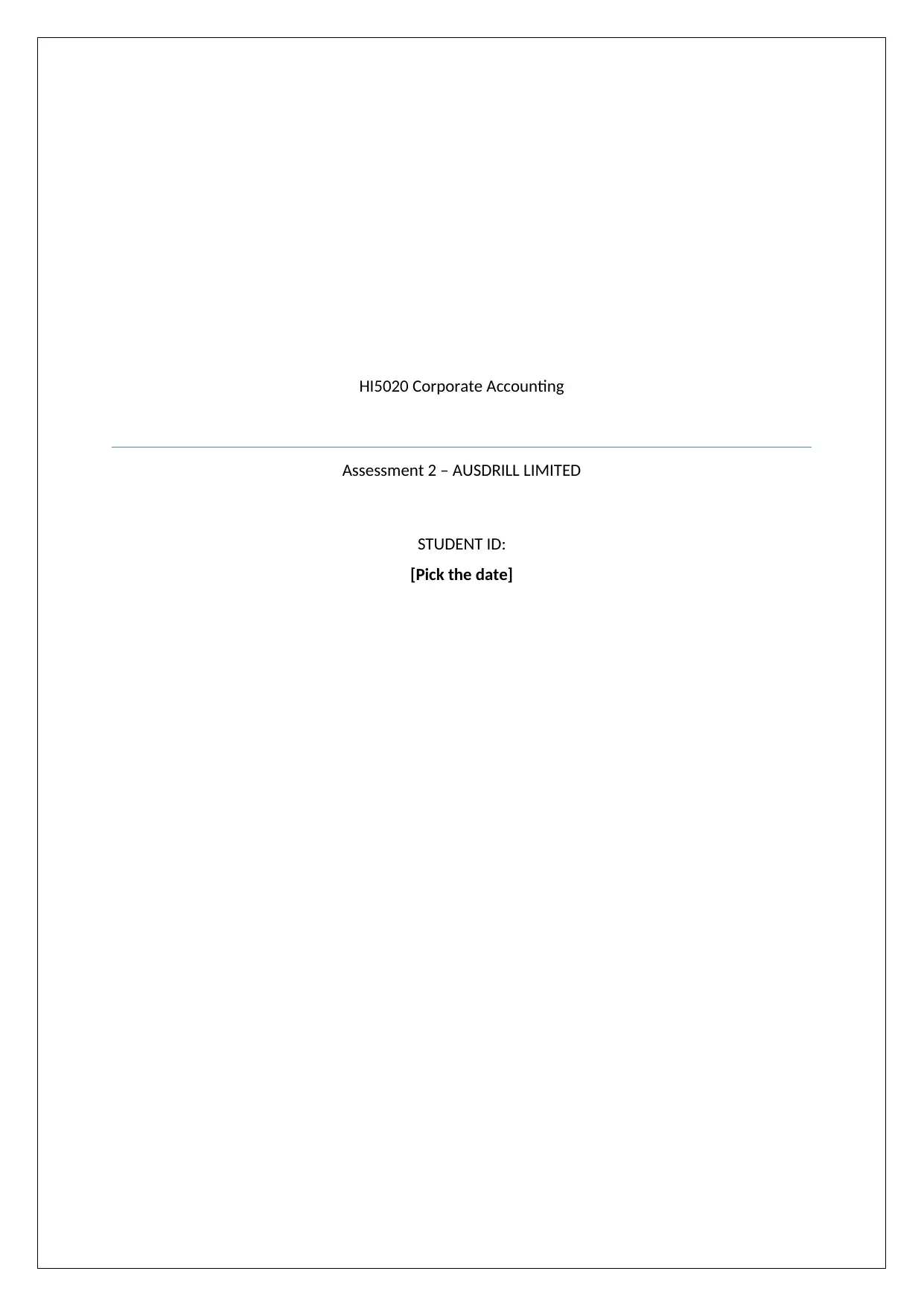
HI5020 Corporate Accounting
Assessment 2 – AUSDRILL LIMITED
STUDENT ID:
[Pick the date]
Assessment 2 – AUSDRILL LIMITED
STUDENT ID:
[Pick the date]
Secure Best Marks with AI Grader
Need help grading? Try our AI Grader for instant feedback on your assignments.
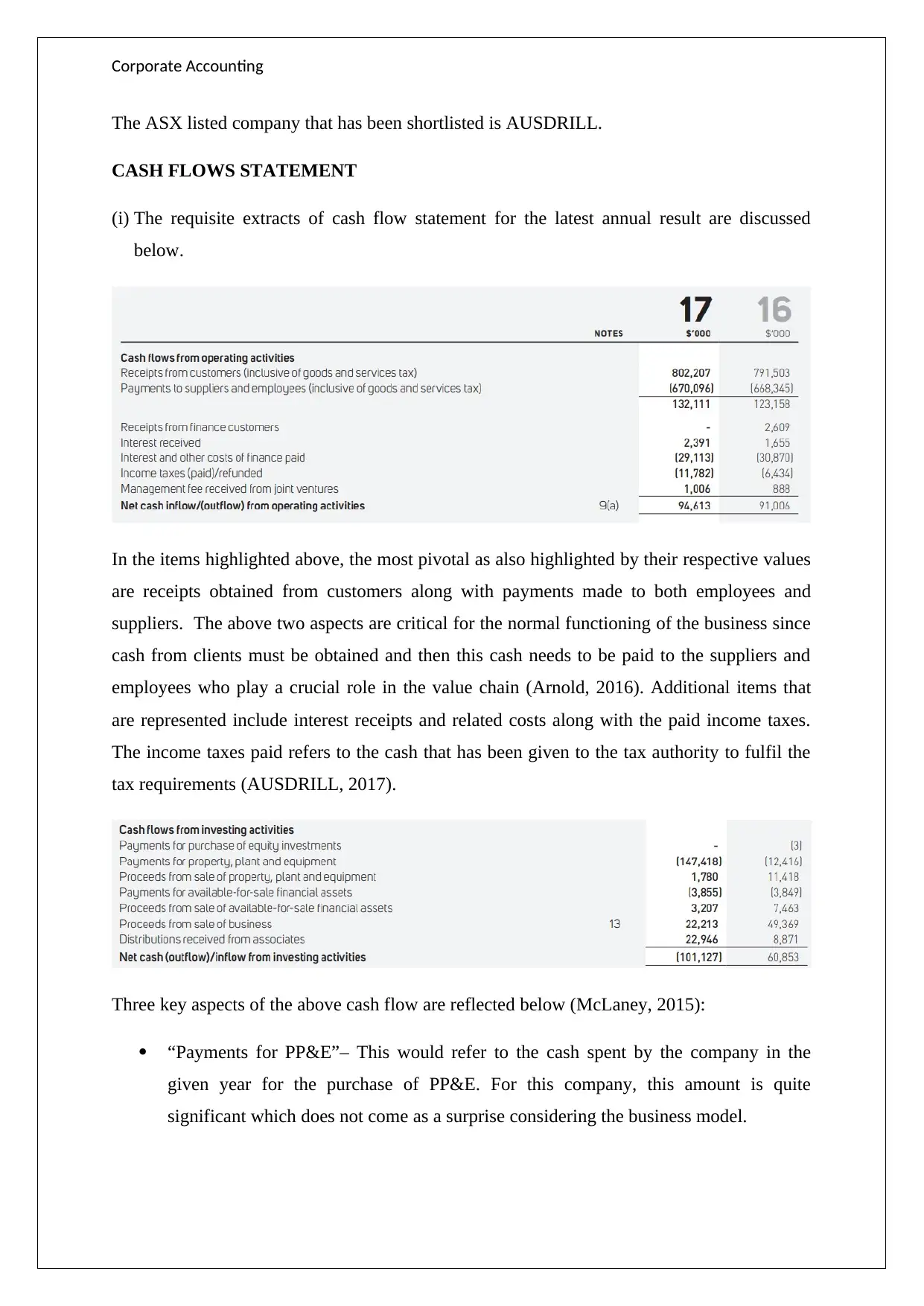
Corporate Accounting
The ASX listed company that has been shortlisted is AUSDRILL.
CASH FLOWS STATEMENT
(i) The requisite extracts of cash flow statement for the latest annual result are discussed
below.
In the items highlighted above, the most pivotal as also highlighted by their respective values
are receipts obtained from customers along with payments made to both employees and
suppliers. The above two aspects are critical for the normal functioning of the business since
cash from clients must be obtained and then this cash needs to be paid to the suppliers and
employees who play a crucial role in the value chain (Arnold, 2016). Additional items that
are represented include interest receipts and related costs along with the paid income taxes.
The income taxes paid refers to the cash that has been given to the tax authority to fulfil the
tax requirements (AUSDRILL, 2017).
Three key aspects of the above cash flow are reflected below (McLaney, 2015):
“Payments for PP&E”– This would refer to the cash spent by the company in the
given year for the purchase of PP&E. For this company, this amount is quite
significant which does not come as a surprise considering the business model.
The ASX listed company that has been shortlisted is AUSDRILL.
CASH FLOWS STATEMENT
(i) The requisite extracts of cash flow statement for the latest annual result are discussed
below.
In the items highlighted above, the most pivotal as also highlighted by their respective values
are receipts obtained from customers along with payments made to both employees and
suppliers. The above two aspects are critical for the normal functioning of the business since
cash from clients must be obtained and then this cash needs to be paid to the suppliers and
employees who play a crucial role in the value chain (Arnold, 2016). Additional items that
are represented include interest receipts and related costs along with the paid income taxes.
The income taxes paid refers to the cash that has been given to the tax authority to fulfil the
tax requirements (AUSDRILL, 2017).
Three key aspects of the above cash flow are reflected below (McLaney, 2015):
“Payments for PP&E”– This would refer to the cash spent by the company in the
given year for the purchase of PP&E. For this company, this amount is quite
significant which does not come as a surprise considering the business model.
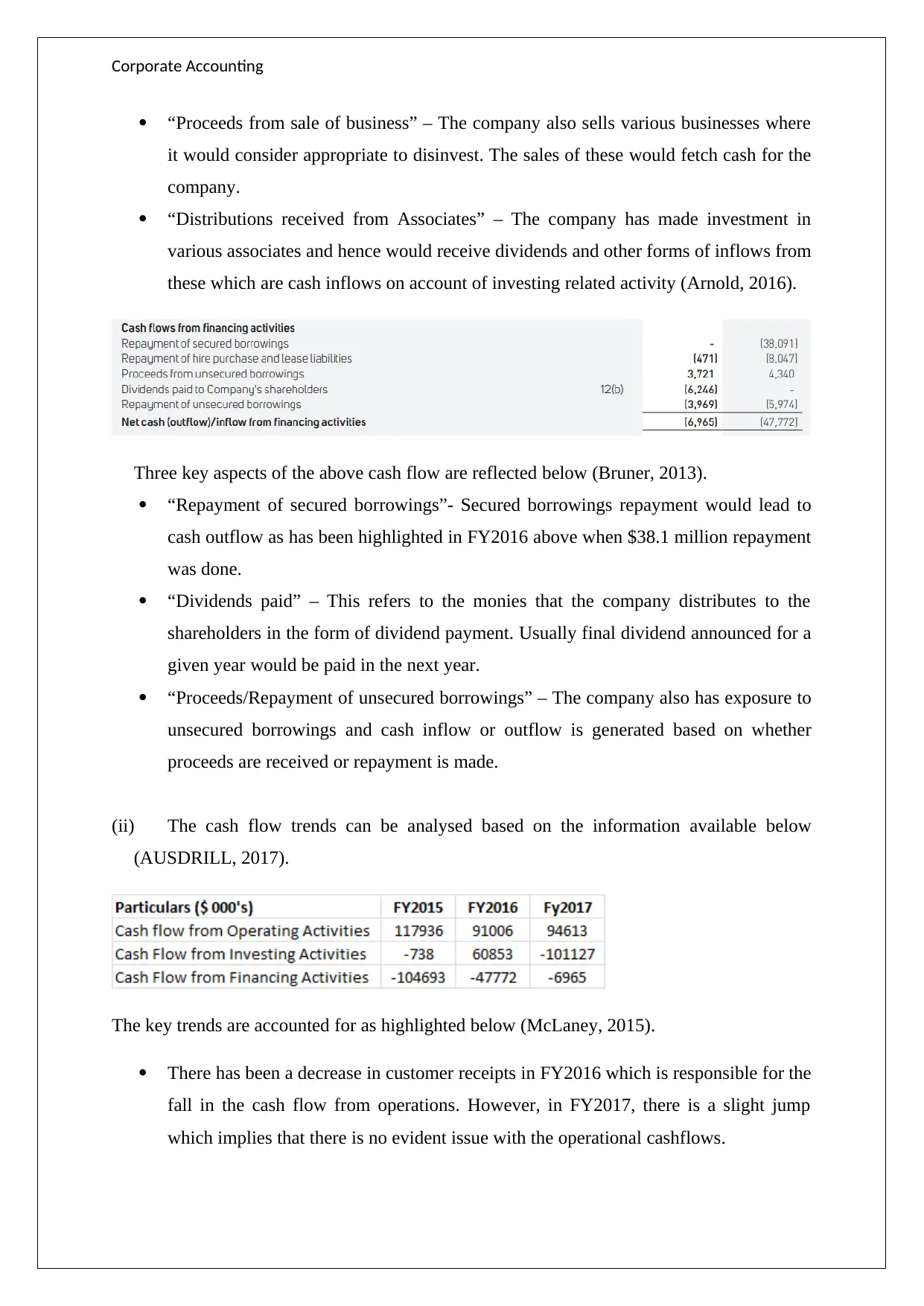
Corporate Accounting
“Proceeds from sale of business” – The company also sells various businesses where
it would consider appropriate to disinvest. The sales of these would fetch cash for the
company.
“Distributions received from Associates” – The company has made investment in
various associates and hence would receive dividends and other forms of inflows from
these which are cash inflows on account of investing related activity (Arnold, 2016).
Three key aspects of the above cash flow are reflected below (Bruner, 2013).
“Repayment of secured borrowings”- Secured borrowings repayment would lead to
cash outflow as has been highlighted in FY2016 above when $38.1 million repayment
was done.
“Dividends paid” – This refers to the monies that the company distributes to the
shareholders in the form of dividend payment. Usually final dividend announced for a
given year would be paid in the next year.
“Proceeds/Repayment of unsecured borrowings” – The company also has exposure to
unsecured borrowings and cash inflow or outflow is generated based on whether
proceeds are received or repayment is made.
(ii) The cash flow trends can be analysed based on the information available below
(AUSDRILL, 2017).
The key trends are accounted for as highlighted below (McLaney, 2015).
There has been a decrease in customer receipts in FY2016 which is responsible for the
fall in the cash flow from operations. However, in FY2017, there is a slight jump
which implies that there is no evident issue with the operational cashflows.
“Proceeds from sale of business” – The company also sells various businesses where
it would consider appropriate to disinvest. The sales of these would fetch cash for the
company.
“Distributions received from Associates” – The company has made investment in
various associates and hence would receive dividends and other forms of inflows from
these which are cash inflows on account of investing related activity (Arnold, 2016).
Three key aspects of the above cash flow are reflected below (Bruner, 2013).
“Repayment of secured borrowings”- Secured borrowings repayment would lead to
cash outflow as has been highlighted in FY2016 above when $38.1 million repayment
was done.
“Dividends paid” – This refers to the monies that the company distributes to the
shareholders in the form of dividend payment. Usually final dividend announced for a
given year would be paid in the next year.
“Proceeds/Repayment of unsecured borrowings” – The company also has exposure to
unsecured borrowings and cash inflow or outflow is generated based on whether
proceeds are received or repayment is made.
(ii) The cash flow trends can be analysed based on the information available below
(AUSDRILL, 2017).
The key trends are accounted for as highlighted below (McLaney, 2015).
There has been a decrease in customer receipts in FY2016 which is responsible for the
fall in the cash flow from operations. However, in FY2017, there is a slight jump
which implies that there is no evident issue with the operational cashflows.
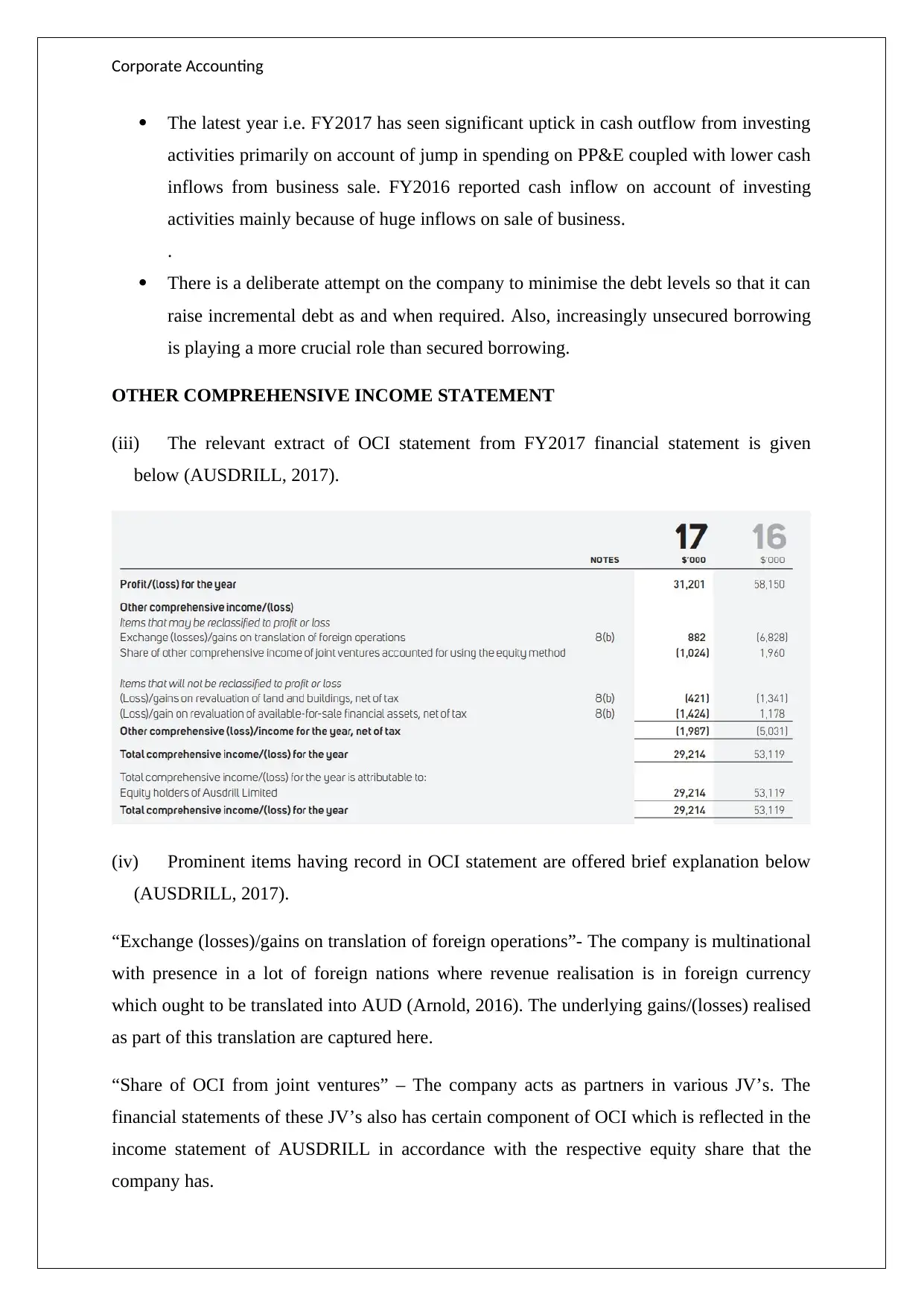
Corporate Accounting
The latest year i.e. FY2017 has seen significant uptick in cash outflow from investing
activities primarily on account of jump in spending on PP&E coupled with lower cash
inflows from business sale. FY2016 reported cash inflow on account of investing
activities mainly because of huge inflows on sale of business.
.
There is a deliberate attempt on the company to minimise the debt levels so that it can
raise incremental debt as and when required. Also, increasingly unsecured borrowing
is playing a more crucial role than secured borrowing.
OTHER COMPREHENSIVE INCOME STATEMENT
(iii) The relevant extract of OCI statement from FY2017 financial statement is given
below (AUSDRILL, 2017).
(iv) Prominent items having record in OCI statement are offered brief explanation below
(AUSDRILL, 2017).
“Exchange (losses)/gains on translation of foreign operations”- The company is multinational
with presence in a lot of foreign nations where revenue realisation is in foreign currency
which ought to be translated into AUD (Arnold, 2016). The underlying gains/(losses) realised
as part of this translation are captured here.
“Share of OCI from joint ventures” – The company acts as partners in various JV’s. The
financial statements of these JV’s also has certain component of OCI which is reflected in the
income statement of AUSDRILL in accordance with the respective equity share that the
company has.
The latest year i.e. FY2017 has seen significant uptick in cash outflow from investing
activities primarily on account of jump in spending on PP&E coupled with lower cash
inflows from business sale. FY2016 reported cash inflow on account of investing
activities mainly because of huge inflows on sale of business.
.
There is a deliberate attempt on the company to minimise the debt levels so that it can
raise incremental debt as and when required. Also, increasingly unsecured borrowing
is playing a more crucial role than secured borrowing.
OTHER COMPREHENSIVE INCOME STATEMENT
(iii) The relevant extract of OCI statement from FY2017 financial statement is given
below (AUSDRILL, 2017).
(iv) Prominent items having record in OCI statement are offered brief explanation below
(AUSDRILL, 2017).
“Exchange (losses)/gains on translation of foreign operations”- The company is multinational
with presence in a lot of foreign nations where revenue realisation is in foreign currency
which ought to be translated into AUD (Arnold, 2016). The underlying gains/(losses) realised
as part of this translation are captured here.
“Share of OCI from joint ventures” – The company acts as partners in various JV’s. The
financial statements of these JV’s also has certain component of OCI which is reflected in the
income statement of AUSDRILL in accordance with the respective equity share that the
company has.
Secure Best Marks with AI Grader
Need help grading? Try our AI Grader for instant feedback on your assignments.

Corporate Accounting
“Gain/(loss) on asset revaluation” – The OCI statement also captures the gain or loss with
regards to revaluation of assets such as land, buildings, financial assets (held for sale) and
these are captured in the OCI.
(v) The requisite reasons for the separate treatment to these items are indicated as follows
(McLaney, 2015).
The framework related to preparation of financial statements mandates that certain
transactions should be recording in the OCI owing to their specific nature and
therefore reporting entities need to comply.
Also, the nature of certain items such as financial instruments captured in the OCI is
such that the loss or gain could be notional and easily susceptible to change the next
year.
Further, the company has no intention to earn any profit from these items as these are
part of the business but not held to earn profits.
ACCOUNTING FOR CORPORATE INCOME TAX
(vi) Income tax expense (FY2017) is $ 13,885,000 in accordance with FY2017 profit and
loss statement (AUSDRILL, 2017).
(vii) The corporate tax rate is 30% and when this is multiple by the accounting income,
the result is $ 13.598 million which is separate from the actual value of $ 13.885 million.
This difference between the two amounts is because of the reconciliation of the accounting
tax so as to obtain tax payable. This requirement arises as the rules governing the tax and
accounting tend to differ. Thus, adjustments for these differences takes place in the
reconciliation as indicated below (AUSDRILL, 2017).
“Gain/(loss) on asset revaluation” – The OCI statement also captures the gain or loss with
regards to revaluation of assets such as land, buildings, financial assets (held for sale) and
these are captured in the OCI.
(v) The requisite reasons for the separate treatment to these items are indicated as follows
(McLaney, 2015).
The framework related to preparation of financial statements mandates that certain
transactions should be recording in the OCI owing to their specific nature and
therefore reporting entities need to comply.
Also, the nature of certain items such as financial instruments captured in the OCI is
such that the loss or gain could be notional and easily susceptible to change the next
year.
Further, the company has no intention to earn any profit from these items as these are
part of the business but not held to earn profits.
ACCOUNTING FOR CORPORATE INCOME TAX
(vi) Income tax expense (FY2017) is $ 13,885,000 in accordance with FY2017 profit and
loss statement (AUSDRILL, 2017).
(vii) The corporate tax rate is 30% and when this is multiple by the accounting income,
the result is $ 13.598 million which is separate from the actual value of $ 13.885 million.
This difference between the two amounts is because of the reconciliation of the accounting
tax so as to obtain tax payable. This requirement arises as the rules governing the tax and
accounting tend to differ. Thus, adjustments for these differences takes place in the
reconciliation as indicated below (AUSDRILL, 2017).
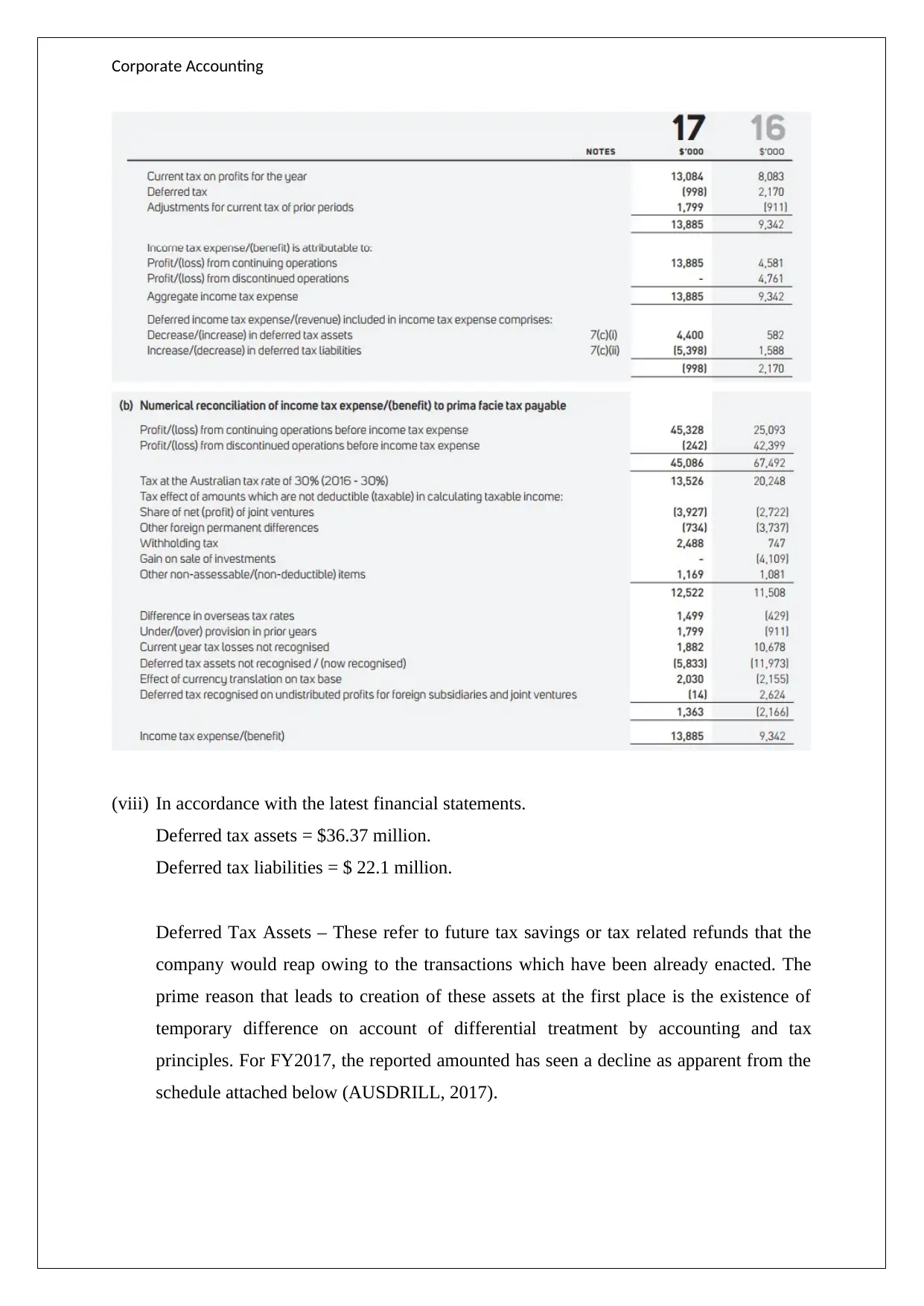
Corporate Accounting
(viii) In accordance with the latest financial statements.
Deferred tax assets = $36.37 million.
Deferred tax liabilities = $ 22.1 million.
Deferred Tax Assets – These refer to future tax savings or tax related refunds that the
company would reap owing to the transactions which have been already enacted. The
prime reason that leads to creation of these assets at the first place is the existence of
temporary difference on account of differential treatment by accounting and tax
principles. For FY2017, the reported amounted has seen a decline as apparent from the
schedule attached below (AUSDRILL, 2017).
(viii) In accordance with the latest financial statements.
Deferred tax assets = $36.37 million.
Deferred tax liabilities = $ 22.1 million.
Deferred Tax Assets – These refer to future tax savings or tax related refunds that the
company would reap owing to the transactions which have been already enacted. The
prime reason that leads to creation of these assets at the first place is the existence of
temporary difference on account of differential treatment by accounting and tax
principles. For FY2017, the reported amounted has seen a decline as apparent from the
schedule attached below (AUSDRILL, 2017).

Corporate Accounting
Deferred Tax Liabilities – These refer to future tax expenses or tax related outflows that
the company would bear owing to the transactions which have been already enacted. The
prime reason that leads to creation of these liablities at the first place is the existence of
temporary difference on account of differential treatment by accounting and tax principles
(Coleman, 2014). For FY2017, the reported amounted has seen a decline as apparent from
the schedule attached below (AUSDRILL, 2017).
Deferred Tax Liabilities – These refer to future tax expenses or tax related outflows that
the company would bear owing to the transactions which have been already enacted. The
prime reason that leads to creation of these liablities at the first place is the existence of
temporary difference on account of differential treatment by accounting and tax principles
(Coleman, 2014). For FY2017, the reported amounted has seen a decline as apparent from
the schedule attached below (AUSDRILL, 2017).
Paraphrase This Document
Need a fresh take? Get an instant paraphrase of this document with our AI Paraphraser

Corporate Accounting
(ix) The company has reported current tax assets to the extent of $ 3.03 million in the
latest financial statements available for FY2017. This amount is lesser when compared to
the corresponding amount for FY2016 which was recorded as $4.80 million (AUSDRILL,
2017). These assets would allow the company to lower the tax outflow by the same
amount during the twelve month period of FY2018 (Coleman, 2014).
The income tax to be paid for a financial year is captured by the income tax expense.
However, income tax payable represents the outstanding tax for the year which additionally
needs to be paid over and above the tax that has already been paid for the current year on an
ongoing basis. Thus, tax payable reflects the part of the tax expense that has not been yet
paid.
(x) As is apparent from the reported numbers for FY2017, the two figures i.e. income tax
expense and the tax paid do not shoe congruence (AUSDRILL, 2017). This is on account
of the following two reasons.
Income tax expense is finalised after a given year ends and therefore tax paid in the
year is based on estimates.
Also, tax paid in a given year can potentially have some component from the
previous year in the form of current tax asset or liability which would influence the
amount paid.
(xi) One confusing aspect about the whole project was the continuation of two systems i.e.
tax and accounting and how the firms actually reconciles between the two through
mechanism such as deferred tax assets/(liabilities). Also, one aspects which was an eye
opener for me was the tax expense computation and the process of reconciliation based on
differences in tax and accounting treatment (Coleman, 2014).
(ix) The company has reported current tax assets to the extent of $ 3.03 million in the
latest financial statements available for FY2017. This amount is lesser when compared to
the corresponding amount for FY2016 which was recorded as $4.80 million (AUSDRILL,
2017). These assets would allow the company to lower the tax outflow by the same
amount during the twelve month period of FY2018 (Coleman, 2014).
The income tax to be paid for a financial year is captured by the income tax expense.
However, income tax payable represents the outstanding tax for the year which additionally
needs to be paid over and above the tax that has already been paid for the current year on an
ongoing basis. Thus, tax payable reflects the part of the tax expense that has not been yet
paid.
(x) As is apparent from the reported numbers for FY2017, the two figures i.e. income tax
expense and the tax paid do not shoe congruence (AUSDRILL, 2017). This is on account
of the following two reasons.
Income tax expense is finalised after a given year ends and therefore tax paid in the
year is based on estimates.
Also, tax paid in a given year can potentially have some component from the
previous year in the form of current tax asset or liability which would influence the
amount paid.
(xi) One confusing aspect about the whole project was the continuation of two systems i.e.
tax and accounting and how the firms actually reconciles between the two through
mechanism such as deferred tax assets/(liabilities). Also, one aspects which was an eye
opener for me was the tax expense computation and the process of reconciliation based on
differences in tax and accounting treatment (Coleman, 2014).

Corporate Accounting
References
Arnold,G. (2016). Corporate Financial Management (3rd ed.). Sydney: Finaicial Times
Management.
AUSDRILL (2017), Annual Report FY2017, [Online] Available at
http://www.ausdrill.com.au/images/ausdrill/files/20170823_AUSDRILL_ANNUAL_
REPORT_2017.pdf (Accessed May 24, 2018)
Bruner, R. F., (2013). Case Studies in Finance (7th ed.). New York City: McGraw-Hill
Education.
Coleman, C. (2014). Australian Tax Analysis (4th ed.). Sydney: Thomson Reuters
(Professional) Australia.
McLaney, E.J., (2015). Business Finance – Theory and Practice (8th ed.). New Jersey:
Prentice Hall.
References
Arnold,G. (2016). Corporate Financial Management (3rd ed.). Sydney: Finaicial Times
Management.
AUSDRILL (2017), Annual Report FY2017, [Online] Available at
http://www.ausdrill.com.au/images/ausdrill/files/20170823_AUSDRILL_ANNUAL_
REPORT_2017.pdf (Accessed May 24, 2018)
Bruner, R. F., (2013). Case Studies in Finance (7th ed.). New York City: McGraw-Hill
Education.
Coleman, C. (2014). Australian Tax Analysis (4th ed.). Sydney: Thomson Reuters
(Professional) Australia.
McLaney, E.J., (2015). Business Finance – Theory and Practice (8th ed.). New Jersey:
Prentice Hall.
1 out of 9
Related Documents
Your All-in-One AI-Powered Toolkit for Academic Success.
+13062052269
info@desklib.com
Available 24*7 on WhatsApp / Email
![[object Object]](/_next/static/media/star-bottom.7253800d.svg)
Unlock your academic potential
© 2024 | Zucol Services PVT LTD | All rights reserved.





